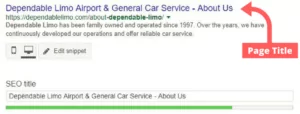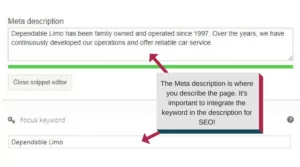
Content
Content may be the single most important aspect your site has in regards to helping your ranking on Search Engine Results Pages! It’s always best practice to have a minimum of 300 words per page, because Search Engine’s interpret this as your page being fruitful with information. Additionally, it’s a great idea for each of your pages on your site to have entirely original content, where it is posted onto your website first. Search Engine’s boost pages that aren’t rehashes of existing content, as well as pages that are the first to post said original content, so it’s always smart to follow this tactic.
Not only is it a good idea to post original content onto your website, it’s also recommended to create content that is well researched and useful. Visitors to your website prefer to read thoroughly written content, not shortened and general blurbs of scattered information. Moreover, the well-researched content that you do publish should be useful information, and isn’t just published to build content on your site. It’s proven that longer articles rank significantly better than shorter articles, so try your best to create useful, original content for your website!
Formatting
Formatting your on-page SEO correctly is absolutely crucial in helping your ranking! Firstly, you must look at the page titles of each page on your site. Write a page title that accurately portrays the content on the page. Beyond this, it’s important to have the title of the page integrating within the content, because this helps search engines understand what the page is about, and a better understanding leads to a higher ranking.
After deciding on an accurate and useful page title, the next step is to create a description of your page. The description portion is the part that visitors see when they search on search engines. It appears beneath the title and allows you to further describe what your page is about. It’s always useful to use the same keyword you used in your page title in this description!
The final aspect when it comes to formatting is the images on your pages. Like writing content, it’s best practice to use original images because it allows search engines to interpret your website as the original source of the image, which greatly helps your ranking. It is also a good idea to us an ALT tag to describe the images on your website, because it gives search engines a better understanding of how to categorize the image.
Internal Linking
Internal linking is a lot like the foundation of a house when it comes to SEO. It’s the framework of your website’s online presence, and allows you to consistently build off of it. When visitors arrive on a page of yours they have found on Google, cross linking allows them to further explore your website, which in turn let’s search engines know about your other pages. Additionally, interlinking pages allows search engines to understand which pages are the most important, due to certain pages being the most interlinked. This helps Google or Bing push these pages to the top!
The internal linking of pages on your website doesn’t just help google understand your site better, it also gives visitors a chance to explore more pages on your website, thus increasing the time visitors spend on your website. Using internal links is a great way to help your SEO, but there are some things to keep in mind. It’s only a good idea to add internal links when they are useful and relevant for the visitor. On top of this, it’s also important to add these links to the main body of your web page, not just the in the footer, because it helps search engines understand its importance.
Did you know we are recognized as a top Massachusetts Digital Marketing Agency on DesignRush? Contact us today!



